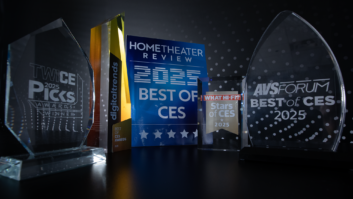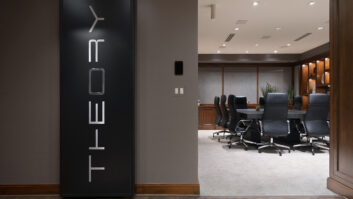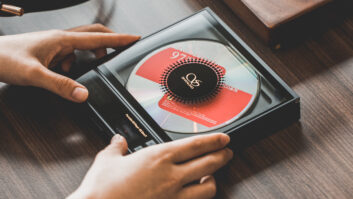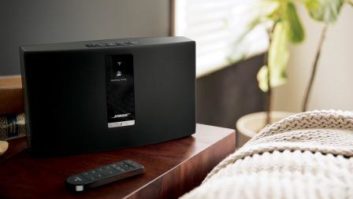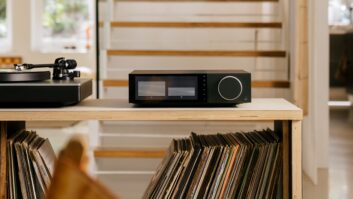NEW YORK – The future of home audio came into clearer focus in 2014, when wireless speakers and soundbars continued to surge while component-audio sales faltered.
Component audio, however, will get a boost in 2015 from the growing availability of components that reproduce Dolby Atmos, the new surround-sound format intended to bring more realism to movie soundtracks, and from the growing availability of AVRs with HDMI 2.0 inputs and outputs and HDCP 2.2 copy protection. The HDCP 2.2-enabled ins/outs pass through new copyprotected 4K-video streaming sources and content from coming 4K discs.
The big gains, however, will come in wireless Bluetooth and Wi-Fi speakers, particularly Wi-Fi speakers that create wireless multiroom-audio systems controlled from mobile devices, suppliers said. The surge reflects the growth of music storage on mobile devices and computers, and it taps into consumer’s desire to enjoy smartphone- and computer-stored music throughout the house and around it without being tethered to a traditional home audio system or PC.
Soundbars will also continue to post gains, though at a slower percentage pace, as they eat into AVR sales, thanks to a growing selection with HDMI switching, higher-performance models that deliver high-quality music reproduction, and models equipped with Bluetooth and wireless multiroom-audio technology.
Suppliers also look to high-resolution audio to make a positive impact on audio categories of all types, though at a modest pace.
Those are some of the key takeaways from a questionnaire emailed by TWICE to key audio suppliers. Here’s what the panelists had to say:
COMPONENT-AUDIO OUTLOOK
TWICE: How did component audio sales (AVRs, speakers, soundbars, components such as DACs, USB DACs, preamps, music servers, two-channel components) fare at the retail in 2014? And what’s the outlook for 2015?
Robert Goedken, Yamaha: In 2014, the market was slightly down in AVRs, speakers and two-channel components, but still up significantly in soundbars and wireless network speakers. We expect the trends to continue. However, AVRs will have a better year and be closer to flat with the increased desire for HDCP2.2 playback with additional content requiring the new copyprotection standard.
Blair Tripodi, Sound United: Our custom loudspeaker business is growing nicely as we see a rebound of new housing starts in the marketplace.
We know that certain consumers will continue to gravitate toward traditional loudspeakers for performance-related reasons, but product categories like multiroom audio and soundbars will continue to shift the focus away from the larger component systems. That being said, certain price bands and technologies are showing promise heading into 2015. We’re optimistic about our product stories and their positioning.
Mike Woulfe, Sony Electronics: In 2014, AVRs sales were down, soundbars continued to outperform prior year, and high-res products including DACs and music servers exceeded expectations. Moving into 2015, we expect to see continued growth in both our soundbar and high-res product lines.
Dean Miller, Lenbrook America: The more popular product categories in 2014 have been headphones, headphones and headphones! The category is now twice as big as the entire loudspeaker category, including soundbars. AVRs have flattened out a bit, as have stand-alone DACs. However, the two-channel market continues to be quite robust. Wireless streaming product is off to the races! The soundbar category is still expanding strongly, with 20 percent growth expected in 2014 over 2013, 15 percent in 2015, and then tapering down to more modest growth of 8 percent, 6 percent and 3 percent in years 2016, 2017 and 2018.
Chris Walker, Pioneer Electronics: Soundbar sales are still increasing this year, especially wireless sub models. We believe customers need more clear and powerful sound for narrow bezel-type TVs. For AVRs, this is an exciting year for us with the launch of the new surround format Dolby Atmos. This format is a great entry and good opportunity to impact both novice and enthusiast home entertainment consumers. The USB DACs are very popular in Japan, and we hope this popularity will grow into the global market.
TWICE: Will Dolby Atmos accelerate component-audio sales in 2015, and why?
Goedkin: Dolby Atmos will be desired by many enthusiasts seeking the ultimate sound experience in their home-theater environments. We will see a lift in higher-end component sales in 2015. We’re already seeing a surge in custom-installation sales with Dolby Atmos components.
Woulfe: We’ll need to wait and see. Market trends are pointing to systems having less speakers (i.e. soundbars), not more.
Miller: We think that early adopters and videophiles will want to upgrade to Atmos as a priority, but for the broader market it will just be another “tick box” feature that may never get used. It is very difficult to get consumers to add additional speakers unless they have a dedicated theater space.
Walker: Yes, we believe that Dolby Atmos will accelerate component audio and speaker sales in 2015. There has not been a major upgrade in surround audio since the introduction of Blu-ray with Dolby TrueHD and DTS-HD Master. Dolby Atmos delivers an audio experience that matches today’s most advanced TVs and the TV and source devices of the future. I believe there will be a good balance between the various types of Atmos speakers (ceiling, add-on and integrated). For most homes with a standard 5.1 surround system, the add-on or integrated Atmos solution makes the most sense because it uses the same footprint as the existing system. In-ceiling solutions will most likely end up in custom and semi-custom environments where products are to be heard and not seem. This does not mean that one method is better than the other; rather, for pretty much any type of environment, there is a solution that delivers a great experience above and beyond a traditional 5.1 experience.
TWICE: Will Atmos systems with inceiling speakers dominate, or will systems with speaker- top Atmos speaker modules?
Goedkin: We will see both in-ceiling and speakertop Atmos speaker modules try to prove their worth in the marketplace this year. It is hard to say which option will be most utilized as it depends on each consumer’s individual situation.
Tripodi: We see Atmos-enabled speaker modules like the Definitive Technology A60 being the most popular consumer choice due to the affordability, ease of installation, and retrofit characteristic that they present. However, Atmos is driving enthusiasm across the board, and so our custom in-ceiling business will benefit consumers wanting a more discrete and higher performing option.
TWICE: Will HDCP 2.2 copy protection over HDMI 2.0 inputs/outputs be necessary features in 2015 AVRs and preamp processors?
Goedkin: HDCP 2.2 will be a must-have for AVR customers in 2015. In fact, there will be such a strong demand for HDCP 2.2-compliant AVRs in 2015 that new receivers without the capability will be dead in the water. HDMI 2.0 product will be more prevalent in 2015, and demand will increase as we start seeing more compatible media players coming out next year.
Woulfe: At certain price points, absolutely. With consumers looking to transition to 4K TV, and price points falling, more consumers will be looking for compatible products with HDCP 2.2.
Miller: Yes. But we expect a lot of consumer confusion and compatibility issues with this new technology. Getting different generations of product to interoperate will be a challenge.
Walker: As HDCP 2.2 displays and source devices become more available, the need for compatible AVRs and preamps will increase. We do believe that the market will see HDCP 2.2 AVRs and pre-amps in 2015.
HIGH-RESOLUTION AUDIO OUTLOOK
TWICE: How important will high-resolution audio be in boosting home audio’s fortunes in 2015?
Goedkin: We see high-resolution audio become an increasingly more important part of our two-channel hi-fi segment. Yamaha recently launched several products that are high-resolution enabled, and they have gained wide interest from our customers.
High-resolution audio is slowly catching on, though still in its infancy for general consumer awareness.
Can the audio industry — vendors and retailers — do more? Yes, the proper demonstration of highresolution audio is the key to selling it over other alternatives.
Woulfe: Sony is dedicated to providing education and awareness that will advance the adoption of high-res. As an industry we need to continue to drive consumers to a better audio experience and let them know that they can experience music in much better ways. We also need to encourage streaming and major download services to start offering high-res content to their customers. The average music consumer won’t be aware of high-res until the content providers start offering it.
Miller: High-resolution audio (HRA) is still in its infancy; however, the buzz is growing tremendously. As of now, it’s still a bit clumsy to download and play back HRA, but it’s improving. A number of streaming music services have announced this file format, and we expect a lot of development in this area over the next couple of years. However, it will most likely remain a niche category until our friends in Cupertino start streaming HRA. The CEA’s audio division is definitely focused on this and has created an initiative in this regard. We expect to see a great deal of development in this area.
Walker: Every audio manufacturer has created high-resolution file playback capability components for several years. This has been the first year audio manufacturers decided to use the same high-resolution logo and promote these products and high-resolution playback more than previous years. We believe high-resolution audio improves the listening experience of the customer and will be in greater demand moving forward.
TWICE: Should suppliers of high-resolution portables be worried about the inclusion of hi-res playback in smartphones?
Woulfe: I think that the more products that support high-res file playback, the better. File size can be large so many consumers will want both devices, depending on their music lifestyle. Since there is no streaming service at the moment, local storage on the device is the only option.
Walker: Some consumers will be happy with the performance of high-resolution playback of their smartphone applications. But manufactures will do a much better job in providing high sound quality that audiophiles expect. The good news is that with smartphones’ huge market penetration, it will definitely raise awareness of high-resolution audio overall, and that is always good for the industry.
WIRELESS MULTIROOM AUDIO
TWICE: What is the outlook for wireless multiroomaudio speakers, receivers, and receiver/amps in 2015 now that more brands have entered the market? Has the category been plagued by high-return rates because of consumer confusion over the capabilities of different types of wireless speakers?
Goedkin: Wireless audio has taken off and resonates with how consumers utilize their content today. As it is now, too many brands have jumped into this market, all seeming to copy the same approach. The main challenge new brands entering this category face is finding their niche and providing enough meaningful differentiation in their products to make them relevant to consumers and establish themselves as significant players in this space.
Tripodi: We are excited by this category and believe it is one of the keys to the future in audio. Because music can be readily enjoyed anywhere from a mobile device, consumer expectations are quickly shifting to enjoying music everywhere and not just where their home theater system resides. With our introduction of 10 products this fall, we have leveraged our combined 67 years of high-performance audio experience to bring the best experience available through an easy-to-use open platform that gives customers choices of the brand they want in the applications they find the most useful. Our Omni S2R, for instance, is the first portable Wi-Fi speaker that goes outside whenever the customer does.
Woulfe: I don’t think there is confusion over different types of wireless speakers. If it’s not stable, easy to use and offers a good user experience, it gets returned, especially with many options readily available. Consumers don’t want to spend hours setting up a speaker or system. The decision to return a product happens within a week.
Miller: The outlook for wireless anything is quite positive due to its inherent simplicity. Insofar as wireless streaming product, we will see more and more entrants into this category as this is how music is now recorded, transmitted and played back. We expect the vendors to fall into their traditional hierarchy of positioning (good, better, best) as these product offerings come to replace their predecessors. There will be mass-market products (Category 1), value-added products (Category 2) and meritbased products or those based upon their incredible performance — like Bluesound (Category 3).
Walker: This category still has a lot of potential. Every manufacture has to make a decision to build their system on an open or on a proprietary closed system like Sonos. Differentiation in an open platform concept will be a key to winning. Additionally, retailers are looking for open platforms systems because of the interoperability between brands, which also helps alleviate consumer confusion at point of sale.
SOUNDBARS SINGING
TWICE: How much are active soundbars growing and why?
Goedkin: Growth in the soundbar category has been steady throughout this past year, and we will continue to see growth in this category as new capabilities and features are included in new product introductions. We see a large number of consumers now using soundbars more for music playback in their homes, and we expect to see that trend accelerate.
Tripodi: We continue to see positive momentum in active soundbars under $1,000. Consumer buying patterns are confirming that soundbars are popular, easy to use, and elegant audio solutions that perfectly complement their flat-panel TV purchase. Our data shows that time-tested audio brands with innovative technologies will continue to be a consumer preference.
While slowing down a bit, this category is still experiencing tremendous growth. Having been the first highperformance loudspeaker brand to enter this space in 2007, we have continued to evolve our designs based on consumer insights. The single most desirable feature from customers is better vocal intelligibility. We have achieved this through our patent-pending Voice Adjust technology we now employ with the recent introduction of the MagniFi and Omni SB1 soundbars. In addition our low-profile designs in both models and DTS Play-Fi in the SB1 allows for better placement under the TV and ability to be part of a whole-home networked solution.
Woulfe: We expect soundbars to continue to grow, and we’ve seen significant growth with higher-pricepoint models. We attribute this growth to several factors.
One, these products are getting easier to use with the inclusion of HDMI switching and Bluetooth music streaming. Two, sound reproduction has increased dramatically over the past few generations. Three, higher-price-point models have been entering the market, allowing greater competition with component solutions, and they are starting to take customers away from the traditional AVR space.
What active soundbar features are most in demand? First and foremost, consumers are looking for a better sound experience that provides richer bass and theater-like surround sound. Today’s consumer doesn’t want to sacrifice sound quality for solution. They want both.
Bluetooth and HDMI are must-haves these days. We anticipate that interest in multiroom functionality will grow in 2015. Consumers aren’t necessarily willing to sacrifice the “home theater” experience for multiroom systems. The integration of wireless multiroom systems with soundbar needs to be executed correctly without sacrificing the overall experience.
Lastly, features that support an easy user experience are important. HDMI connectivity is an important part of this as it enables an easy connection to the TV as well as allows the soundbar to become their new home-theater hub by allowing consumers to plug in gaming consoles, cable boxes, BD players, etc. into it — similar to the role the AVR has traditionally played.
On the higher end of the spectrum, soundbars have impacted AVR sales. High-end soundbars like our ST7 have proved to be a competitor for some of the similarly priced HTIB or AVR + speakers. As high-end soundbars continue to evolve, I believe they’ll continue to impact AVR market.
Miller: This category is very dependent on TV sales because the soundbar is often an add-on sale. As the price of TVs continues to drop, it also puts downward price pressure on the soundbar category.
Simplicity of setup and operation are the most important soundbar attributes. Integration with multiroom audio is a strong step-up feature.
Soundbars in general have had an impact on AVR sales. But it is the simplicity of integrating soundbars with TVs that create the consumer attraction, not the soundbar features or performance.
Walker: Soundbars have slowed a bit but are still growing. 2015 should grow at the same rate as this year.
TWICE: How did sales go for under-TV speakers (soundbases) in 2014, and what’s the outlook for 2015?
Woulfe: Often because of space limitations, the soundbase customer is looking for a sound solution for their TV that offers a smaller size but doesn’t sacrifice quality. Sound features that are geared to the home-theater experience (i.e. integrated subwoofers) are important to help give more depth and theater-like feel to the sound experience. [Soundbase] consumers are responding to similar features found in soundbars like HDMI and Bluetooth connectivity.
Miller: We don’t make any … yet.
TWICE: What other home-audio segments grew in 2014, and what will grow in 2015?
Tripodi: Portable Bluetooth speakers continue to show massive growth. Our Boom by Polk Swimmer loudspeaker has set a new standard for an incredibly flexible high-performance, rechargeable system that is totally submersible and meets the IP7 standard for a waterproof product. In addition, it is allowing us to take the Polk brand to new and disruptive retail partners outside the traditional CE space, therefore exposing the Polk and Boom by Polk brands.
Miller: Stand-alone Bluetooth speakers have waned quite a bit. We expect that the real growth will come from products that reside on a consumer’s network. Streaming seems to have a big, big future!
Walker: We still look towards soundbars, wireless speakers and headphones as growing segments in audio. Dolby Atmos should present a growing opportunity in the future as more Dolby Atmos titles are released and consumer awareness grows.
Key Takeaways
» The traditional home audio segments – receivers and speakers – are faltering, but soundbars, wireless-multiroom speakers, and home and portable DACs are surging.
» High-end active soundbars are drawing sales from component A/V receivers and accounting for a growing amount of music listening at home.
» Dolby Atmos surround will lift component audio sales in 2015, but suppliers split on how strong the gains will be.
» HDMI 2.0 ins/outs with HDCP 2.2 copy protection will be must-haves in component audio electronics, at least at higher price points.
» High-resolution audio is slowly catching on with consumers, and awareness will accelerate if major streaming and download service offer it.




